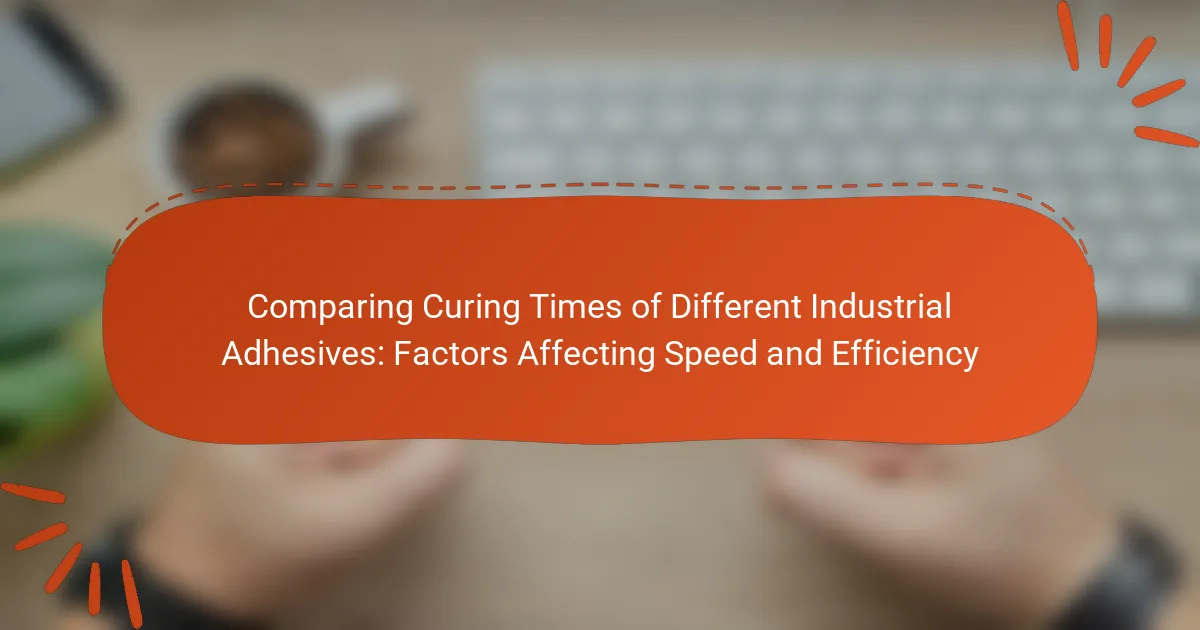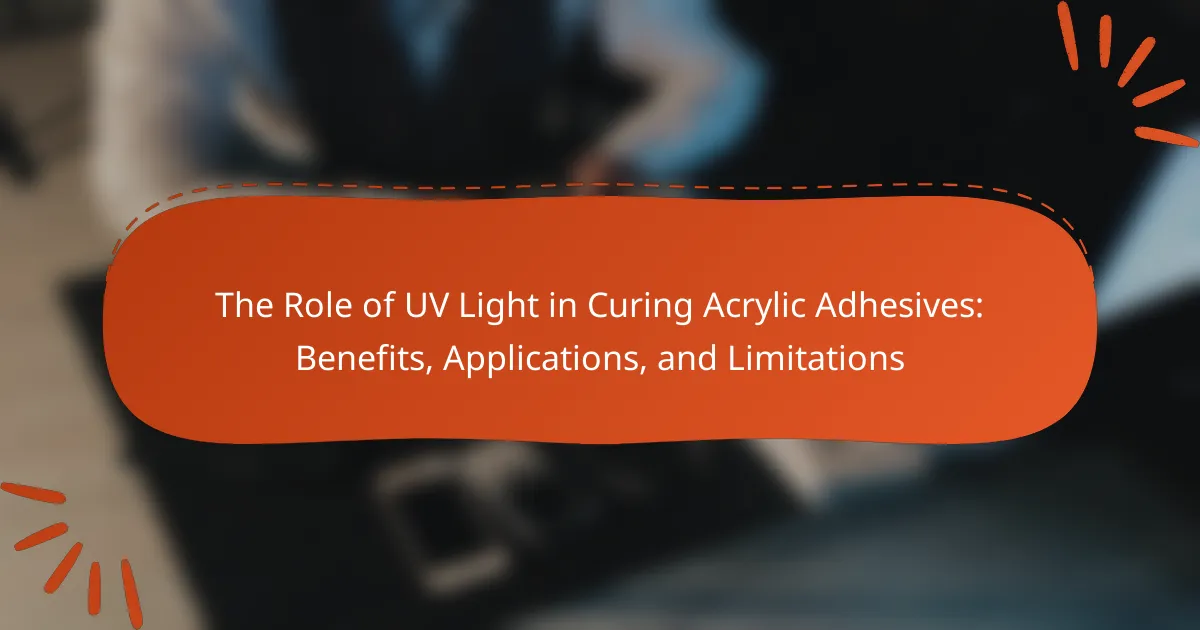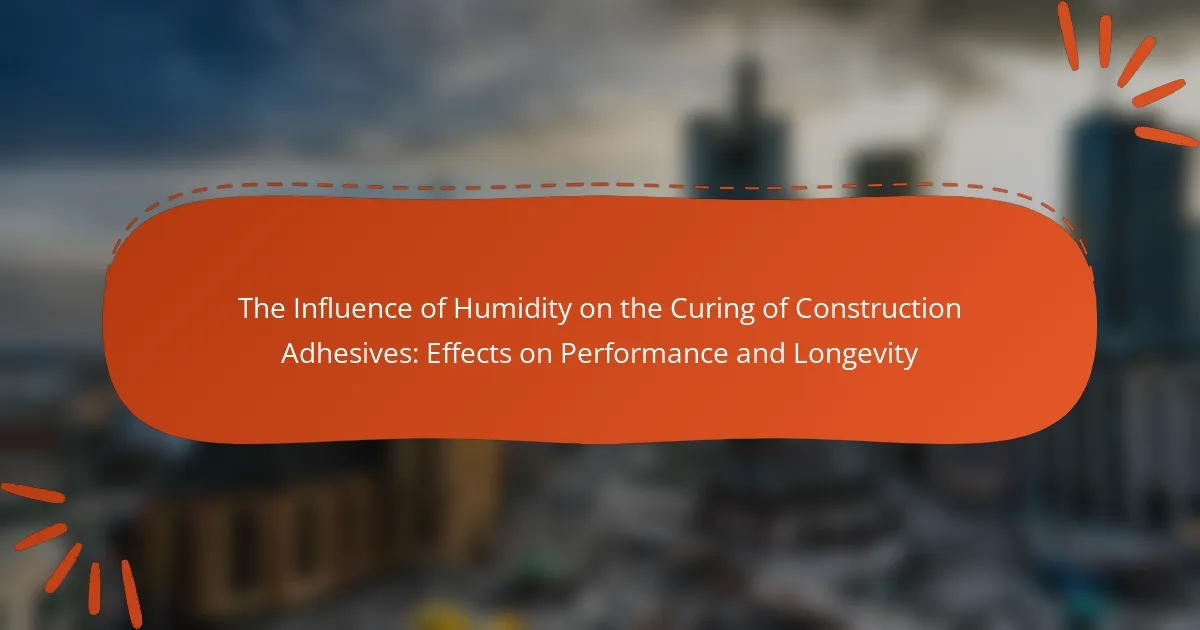This article examines the curing times of various industrial adhesives, including epoxy, polyurethane, cyanoacrylate, acrylic, and silicone. Key factors influencing the speed of curing are identified, such as temperature, humidity, adhesive formulation, and substrate properties. Methods to optimize curing times, including controlling environmental conditions, adjusting adhesive formulations, and improving surface preparation, are discussed. The relationship between temperature increases and reduced curing times is also highlighted, along with the impact of application thickness and the use of UV light for certain adhesives. This comprehensive overview provides insights into enhancing the efficiency of industrial adhesive applications.
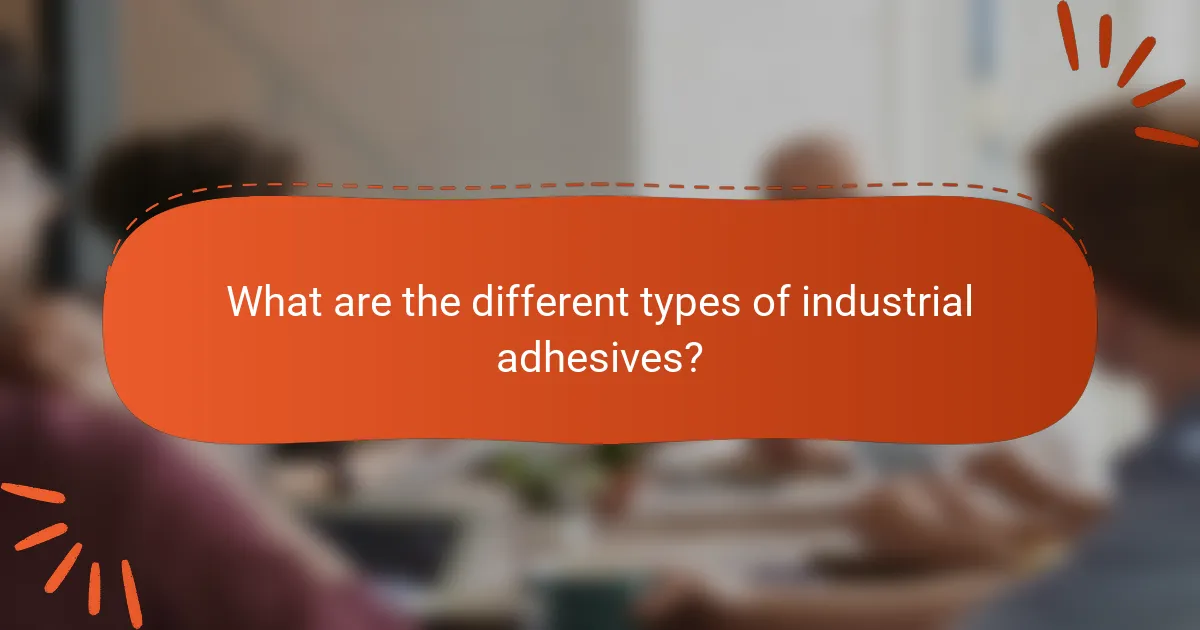
What are the different types of industrial adhesives?
The different types of industrial adhesives include epoxy, polyurethane, cyanoacrylate, acrylic, and silicone. Epoxy adhesives are known for their strong bonding capabilities and resistance to heat and chemicals. Polyurethane adhesives offer flexibility and durability, making them suitable for various materials. Cyanoacrylate adhesives, commonly known as super glue, bond quickly and are ideal for small repairs. Acrylic adhesives provide strong bonds and are often used in construction and manufacturing. Silicone adhesives are flexible and water-resistant, commonly used in sealing applications. Each adhesive type has specific applications based on its properties and performance.
How do curing times vary among these types?
Curing times for different industrial adhesives vary significantly based on their chemical composition and application methods. For example, epoxy adhesives typically require 24 to 72 hours to fully cure. In contrast, cyanoacrylate adhesives can cure in as little as 10 to 30 seconds. Polyurethane adhesives generally take 1 to 24 hours for initial curing, depending on environmental conditions. Factors such as temperature, humidity, and adhesive thickness also influence curing times. For instance, higher temperatures can accelerate curing, while increased humidity may slow it down. These variations highlight the importance of selecting the appropriate adhesive for specific applications based on desired curing times.
What factors influence the curing times of each type?
Curing times of industrial adhesives are influenced by several factors. Temperature affects the speed of chemical reactions in adhesives. Higher temperatures generally lead to faster curing. Humidity levels also play a role; higher humidity can accelerate curing for some adhesive types. The type of adhesive determines its specific curing mechanism, influencing time. Surface preparation, such as cleanliness and roughness, impacts adhesion and curing efficiency. Additionally, the thickness of the adhesive layer affects curing; thinner layers typically cure faster. Finally, the presence of catalysts or accelerators can significantly reduce curing times. Each of these factors interacts to determine the overall curing time for different adhesive types.
Are there specific applications that require faster curing adhesives?
Yes, there are specific applications that require faster curing adhesives. Industries such as automotive, aerospace, and electronics often demand quick bonding solutions. In automotive assembly, for instance, faster curing adhesives reduce production time and enhance efficiency. In aerospace applications, rapid curing is crucial for meeting tight deadlines and ensuring structural integrity. Electronics manufacturing also benefits from faster curing to expedite the assembly process. These industries rely on adhesives that cure quickly to maintain workflow and meet stringent timelines.
What are the common attributes of industrial adhesives?
The common attributes of industrial adhesives include bonding strength, curing time, and chemical resistance. Bonding strength refers to the adhesive’s ability to hold materials together under stress. Curing time is the duration required for the adhesive to reach its optimal strength. Chemical resistance indicates how well the adhesive withstands exposure to various substances. Other attributes are temperature resistance, flexibility, and viscosity. Temperature resistance ensures performance in extreme conditions. Flexibility allows for movement between bonded materials. Viscosity affects application ease and spreadability. These attributes are critical for selecting the appropriate adhesive for specific industrial applications.
How do these attributes affect performance in various industries?
Attributes such as curing time, adhesion strength, and environmental resistance significantly affect performance in various industries. Shorter curing times enhance production efficiency in manufacturing. Industries like automotive benefit from fast-curing adhesives, reducing assembly times. Higher adhesion strength improves durability in construction applications. Environmental resistance attributes ensure longevity in outdoor products. For example, adhesives with high moisture resistance are crucial in marine applications. These attributes directly influence operational costs and product reliability across sectors.
What role does viscosity play in curing times?
Viscosity significantly influences curing times in industrial adhesives. Higher viscosity typically results in slower curing times. This is because thicker adhesives have reduced flow and interaction with surfaces. Consequently, they may not spread evenly, leading to less effective bonding. Conversely, lower viscosity adhesives cure faster due to better wetting and [censured] into surfaces. Research shows that adhesives with a viscosity of around 1000 cP cure within 24 hours, while those with 10,000 cP can take several days. Therefore, viscosity is a critical factor in determining the efficiency and speed of adhesive curing processes.
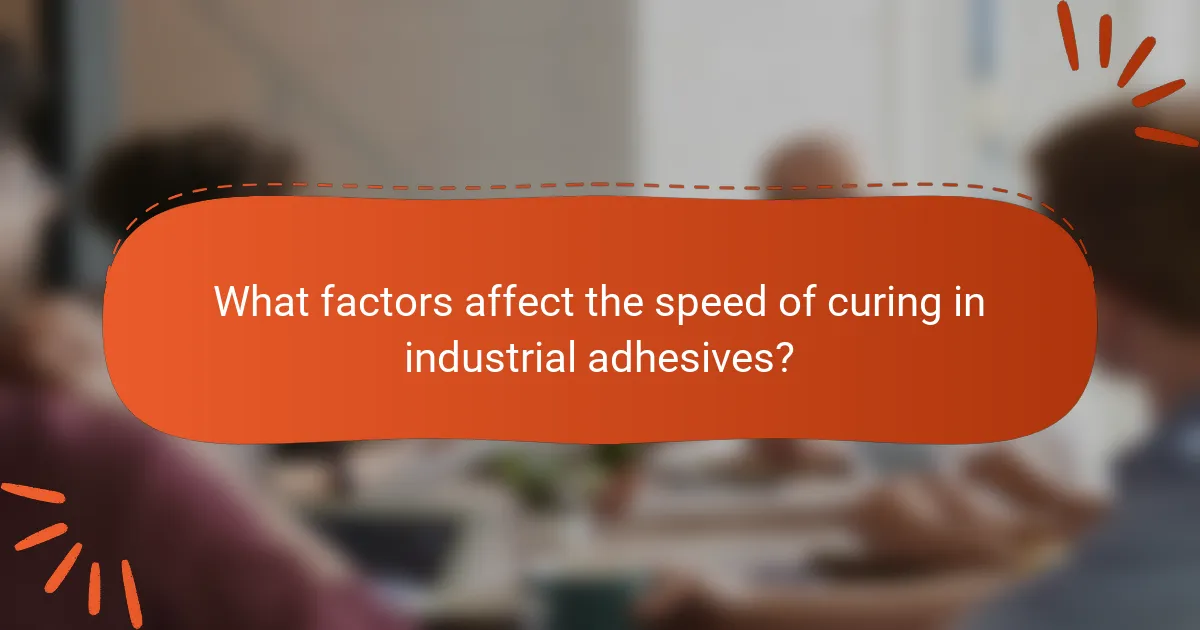
What factors affect the speed of curing in industrial adhesives?
The speed of curing in industrial adhesives is affected by several key factors. These factors include temperature, humidity, adhesive formulation, and substrate properties. Higher temperatures generally accelerate curing rates due to increased molecular activity. Humidity can also influence curing, particularly in moisture-curing adhesives, where higher humidity levels can enhance the curing process. The specific formulation of the adhesive, including its chemical composition and presence of catalysts, plays a crucial role in determining curing speed. Additionally, the nature of the substrates being bonded can affect the adhesive’s performance and curing time. For example, porous substrates may absorb adhesive components, impacting the curing process.
How does temperature impact curing times?
Temperature significantly impacts curing times of adhesives. Higher temperatures typically accelerate the curing process. This is due to increased molecular activity, which promotes faster chemical reactions. For instance, many adhesives cure faster at temperatures above 70°F (21°C). Conversely, lower temperatures slow down these reactions, extending curing times. For example, at temperatures below 50°F (10°C), some adhesives may take several hours longer to cure. Research indicates that for every 10°F increase in temperature, the curing time can be reduced by approximately 50%. This relationship emphasizes the importance of temperature control in adhesive applications.
What is the optimal temperature range for different adhesives?
The optimal temperature range for different adhesives varies by type. For epoxy adhesives, the ideal range is typically between 70°F to 100°F (21°C to 38°C). Polyurethane adhesives perform best at temperatures from 60°F to 80°F (16°C to 27°C). Cyanoacrylate adhesives, commonly known as super glues, cure effectively between 50°F and 90°F (10°C to 32°C). Acrylic adhesives can be applied within a range of 50°F to 100°F (10°C to 38°C). These ranges ensure proper curing and adhesion. Temperature affects the viscosity and curing speed of adhesives. Higher temperatures generally accelerate curing, while lower temperatures can slow the process.
How does ambient humidity influence curing speed?
Ambient humidity significantly influences curing speed. High humidity levels can slow down the curing process of adhesives. This occurs because moisture in the air can interact with adhesive components, affecting their chemical reactions. Conversely, low humidity can accelerate curing by promoting faster evaporation of solvents. Research indicates that adhesives may require specific humidity ranges for optimal performance. For instance, some adhesives cure best between 40% to 60% relative humidity. Outside this range, the curing speed may decrease or become unpredictable.
What is the role of adhesive formulation in curing efficiency?
Adhesive formulation significantly influences curing efficiency. The composition determines how quickly and effectively the adhesive sets. Factors such as resin type, hardener ratio, and additives directly impact the curing process. For example, epoxy adhesives cure faster with higher hardener content. Additionally, the presence of accelerators can reduce curing time. Specific formulations can enhance temperature tolerance, allowing for quicker curing in varying conditions. Overall, careful formulation leads to optimized curing times and improved bond strength.
How do additives impact the curing process?
Additives significantly influence the curing process of industrial adhesives. They can accelerate or retard the curing time depending on their chemical composition. Accelerators, for instance, enhance the rate of polymerization, leading to faster curing. In contrast, retarders slow down the curing process, allowing for extended working times.
Certain additives also improve the final properties of the cured adhesive. For example, fillers can enhance viscosity and strength. Additionally, plasticizers can increase flexibility and reduce brittleness.
Research indicates that the type and concentration of additives directly affect the thermal and mechanical properties of the cured adhesive. Studies show that specific formulations can reduce curing times by up to 50%.
What unique formulations are available for specific applications?
Unique formulations of industrial adhesives include epoxy, polyurethane, and cyanoacrylate. Epoxy formulations are known for their strong bonding capabilities and resistance to heat and chemicals. They are often used in construction and automotive applications. Polyurethane adhesives offer flexibility and durability, making them suitable for wood and fabric bonding. Cyanoacrylate, commonly known as super glue, provides rapid bonding for small repairs and is effective on various surfaces. Each formulation is tailored for specific applications based on their unique properties. These specialized formulations ensure optimal performance in different industrial contexts.

How can one optimize curing times for industrial adhesives?
To optimize curing times for industrial adhesives, one should control environmental conditions. Temperature significantly influences curing speed. Higher temperatures generally accelerate curing processes. Humidity levels also play a crucial role; optimal humidity can enhance adhesive performance.
Adjusting the adhesive formulation can lead to faster curing. Using accelerators or hardeners can reduce curing times effectively. The application thickness should be minimized; thinner layers cure faster.
Surface preparation is essential; clean and roughened surfaces improve adhesion and speed up curing. Additionally, using UV light can expedite curing for certain adhesives.
These methods are supported by studies showing that temperature increases can halve curing times in some adhesives.
What best practices should be followed for efficient curing?
Efficient curing requires optimal temperature and humidity control. Maintaining a consistent temperature enhances adhesive performance. Ideal humidity levels prevent premature curing and ensure proper adhesion. Proper surface preparation is essential for good bonding. Clean and dry surfaces improve adhesive effectiveness. Applying the adhesive evenly promotes uniform curing. Using the recommended adhesive thickness prevents issues during the curing process. Monitoring curing times according to manufacturer guidelines is crucial. Following these practices maximizes adhesive strength and durability.
How can surface preparation affect adhesive performance?
Surface preparation significantly affects adhesive performance. Proper surface preparation enhances adhesion by increasing the contact area between the adhesive and the substrate. It removes contaminants, such as dust, oil, and moisture, which can interfere with bonding. Additionally, surface roughness can improve mechanical interlocking, leading to stronger bonds. Studies show that prepared surfaces can increase adhesive strength by up to 50%. Conversely, poor preparation can result in weak bonds and premature failure. Therefore, effective surface preparation is crucial for maximizing adhesive performance.
What techniques can be used to control environmental factors?
Techniques to control environmental factors include regulating temperature, humidity, and airflow. Temperature control can be achieved using thermostats and heaters or coolers. Humidity can be managed with dehumidifiers or humidifiers, depending on the needs. Airflow can be adjusted with fans or ventilation systems to ensure proper circulation. These methods help create optimal conditions for adhesive curing. Studies show that maintaining a stable environment can significantly improve adhesive performance and curing times. For instance, a controlled temperature of 20-25 degrees Celsius is often recommended for many adhesives to achieve maximum effectiveness.
What troubleshooting tips can improve curing efficiency?
Optimize environmental conditions to improve curing efficiency. Ensure consistent temperature and humidity levels during the curing process. Ideal temperatures generally range from 70°F to 85°F. Humidity should be controlled between 30% and 50% for optimal adhesion.
Use appropriate adhesive types for specific materials. Different adhesives have varying curing times and conditions. Select adhesives that match the substrates for better performance.
Inspect surface preparation before application. Clean and dry surfaces enhance adhesive bond strength. Contaminants can significantly delay curing times.
Monitor curing time as specified by the manufacturer. Following recommended curing times ensures optimal performance. Deviating from these guidelines can lead to incomplete curing.
Use accelerators if applicable. Some adhesives allow for curing accelerators that can speed up the process. Always verify compatibility with the adhesive being used.
Regularly maintain equipment and tools. Clean tools prevent contamination that can affect curing. Equipment should be calibrated to ensure consistent application.
Finally, test small batches before large-scale application. Conducting small tests helps identify potential issues early on. This approach can save time and resources in the long run.
How can one identify and resolve common curing issues?
Common curing issues can be identified through visual inspection and testing. Signs include incomplete adhesion, surface tackiness, or improper bonding strength. Each of these indicators suggests a potential problem with the curing process.
To resolve these issues, first ensure that the adhesive is mixed and applied according to the manufacturer’s specifications. Adjusting temperature and humidity can also significantly impact curing times and effectiveness.
For example, higher temperatures typically accelerate curing, while lower temperatures may prolong it. Conducting adhesion tests can verify if the adhesive has cured properly. If problems persist, consider switching to a different adhesive formulation better suited for the specific application conditions.
What resources are available for further learning about adhesive curing times?
Books on adhesive technology provide in-depth information on curing times. “Adhesive Bonding: Science, Technology and Applications” by A. P. P. K. D. N. R. A. is a comprehensive resource. Technical papers from organizations like the American Institute of Chemical Engineers offer research findings on curing processes. Online courses from platforms like Coursera and edX cover adhesive applications and curing mechanisms. Manufacturer websites often include technical data sheets detailing curing times for specific products. Industry journals such as the “Journal of Adhesion Science and Technology” publish studies on adhesive performance and curing factors.
The main entity of this article is industrial adhesives, specifically focusing on their curing times and the factors that influence these times. The article provides an overview of various types of industrial adhesives, including epoxy, polyurethane, cyanoacrylate, acrylic, and silicone, highlighting their unique attributes and applications. Key factors affecting curing times such as temperature, humidity, adhesive formulation, and surface preparation are discussed, along with best practices for optimizing curing efficiency. Additionally, the article addresses common curing issues and offers resources for further learning about adhesive technology.
